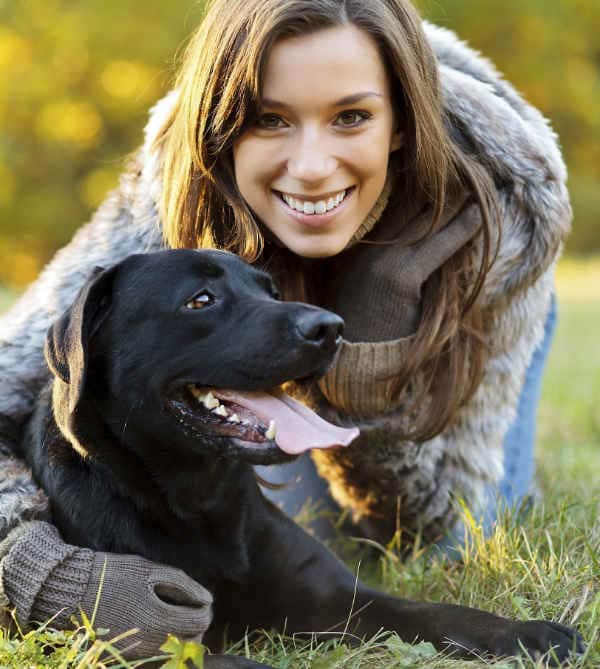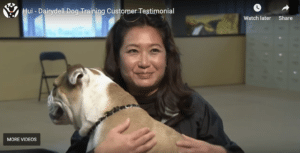Few things can be more heartbreaking to a dog owner than when their adored young dog turns “without warning” into a biter. Although not necessarily common, this situation replays with unwelcome frequency in young dogs as they mature (usually between one and three years of age) leaving many a dog owner bewildered, confused and even angry.
They did everything right in raising their puppy – the best care, lots of love and attention, never treated the puppy harshly — even enrolled in some obedience classes. And yet, two to three years into their blissful life together, their perfect dog starts barking at visitors and passers-by, then it snaps at a child, bites the vet, the groomer will no longer take him and their favorite boarding kennel asks them to find other accommodations. HOW DID THIS HAPPEN??
Though the vexed owner looks for someone to blame (the children walking by must have taunted him, the groomer must have nicked him, the kennel must have frightened him or the trainer must have abused him) the fact of the matter is simply that this puppy’s “new” behavior may have been predestined from the start if its genetics were aligned just so. Here’s what I mean:
Some elements of a dog’s behavior – those behaviors that are controlled by conscious thought – can be molded to a large degree by training and guided by the careful nurturing of dedicated owners. That is to say, when a dog has a choice of behaviors presented to it, training can help make sure the “right” or desired choice is made by the dog. For example, whether a dog decides to come when he’s called or not, or whether he jumps uncontrollably during greetings or decides to keep four on the floor– can definitely be affected by training.
Instinctive behaviors, on the other hand, cannot be changed by training. That’s because instincts bypass conscious thought and are purely reactive in nature. They are usually survival-related. Things like fear response, fight or flee, reproduction and even the instinct to hunt and chase are all related to a dog’s survival. We call these hard-wired behaviors and training, per se, is no match for Mother Nature when it comes to stopping or extinguishing instinctive behaviors. The best training can do is modify the threshold at which an instinct is triggered or develop a “stop” response when a dog goes into instinct mode. Training will never keep the instinctive response from happening in the first place, however.
Back to the dog and guests to the home. While jumping behavior can be controlled by training, whether or not a dog is afraid of guests is another matter altogether. Whether or not they are trained, some dogs will be fine with strangers coming into their home while others will fear these strangers. Ultimately it is a dog’s innate personality (soft or bold) that will determine his baseline degree of confidence or lack of it and neither owners nor trainers can create a personality or change one into another. The old adage, ‘You can’t make a silk purse out of a sow’s ear” comes to mind. Neither can a leopard change his spots.
Biting
Most biting, in my experience, is fear-based. Yet not all dogs that are afraid, bite. And what frightens one dog may not raise an eyebrow on another. And as if this is not complicated enough, all of the contributing aspects of a dog’s ultimate inner self are not apparent in puppyhood. Some elements of a dog’s adult personality take up to 3 years to reveal themselves!
3 Key Elements Can Create the Perfect Storm for Biting
I have spent years studying dogs and their behavior. In particular, aggression. Aggression of one form or another is the number one consultation topic on my calendar each week. Most cases involve leash aggression toward other dogs. This is much more common – and more easily controlled – than aggression toward humans. The latter, however, causes the biggest problems – and the most confusion. It’s why I chose to write this article.
Most dog owners whose dogs are biting people arrive at my office with the same back-story: a sweet puppy now gone “bad.” All breeds, all sizes, all socialized and all with good home environments. Most importantly, however, they all share three key elements in their hard—wiring:
- Soft personality
- Active defense
- Low bite Inhibition
When these three elements line up in the same dog, biting is likely in that dog’s future unless careful management is undertaken by the owner to keep the dog from reaching his threshold. Generally, it’s not a question of if this dog will bite, but when.
Soft Personality
Like humans, dogs come in all personality types, from shy to bold and weak to strong. “Soft” personalities can come across as either shy, skittish, wary, careful, fearful or just deep thinkers. Soft personality dogs are contrasted with their bolder cousins – the stronger personalities that are bold, active, willful, pushy and/or energetic. Soft personalities are more likely to consider new or unknown experiences as possibly dangerous or threatening, because of their lower degree of self-confidence. Strong personality dogs think new things are fun and embrace them willingly.
Active Defense
Remember high-school biology and studying the fight-or-flee response? It’s alive and well in dogs! When faced with a perceived threat or danger, all dogs will instinctively go into defense mode. It’s a matter of survival. But their personal go-to method of defense depends on their hard-wiring. They will either tend to be a fighter or a flee-er.
Some dogs will instinctively retreat from danger if retreat is at all possible They survive by avoiding conflict at all costs. They might look away, leave the scene, roll on their back in a display of submission, etc. We say this type of dog has “passive defense.” A soft personality dog with passive defense will generally not become a problem biter, because they’d rather avoid the scary thing than confront it.
On the other hand, there are dogs that instinctively prefer to destroy the threat before it destroys them, rather than run away from it. These are dogs that prefer the fight to the flee, and we say they have “active defense.” Dogs with active defense will bark towards what frightens them, often moving forward with the bark as if to say “Get back!” “I’m warning you!” “Get away from here!” Soft personality dogs with active defense are just a whisker away from biting. Whether or not they do will depend on the last of our three elements: their level of bite inhibition.
Bite Inhibition
All dogs have the option to bite, but some exercise this option willingly while other try to resist it, considering biting their last resort rather than their first. If dogs were carpenters and biting was one of their tools, some bury the biting tool deep in their toolbox, preferring other means to fix a problem whenever possible. We say these dogs are hard-wired for high bite inhibition. They are highly inhibited from using their bite.
Other dogs keep the bite tool right at the top of their tool bag and it’s their go-to for most any major problem encountered. These are the dogs with low bite inhibition. They are not inhibited much at all when it comes to using their teeth to solve a problem. In the case of a soft personality dog with active defense AND low bite inhibition….beware and be prepared. They’ve been dealt three strikes by Mother Nature and like I said, it’s not a matter of if they will bite, but more a matter of when.
Dominance-Based Biting
Are only soft-personality dogs at risk of biting someone? Not at all, though it is much, much more common in soft personality dogs and fear-inducing situations. Some other bites are “disciplinary.” A bolder dog with more confidence than sense and who fancies himself king of all he surveys may well bite to bring his perceived underlings into line. He’s not afraid – he’s offended by their lack of respect. Dominance-base,d disciplinary biting is much less common, but it too is exacerbated by active defense and low bite inhibition in the Dog-that-would-be-King.
When “Good” Puppies Go “Bad” – Defense Mode and Bite Inhibition Reveal Themselves Over Time
The sad fact is that while basic personality types (soft or bold) are evident even in young puppies, the final character of a that puppy’s defense mode and bite inhibition level will not be seen until he begins to mature at about two to three years of age! Just like human children that start out as trusting and naïve explorers in a new world, so do puppies. They begin life fairly accepting of new people and things. But, like us, they gradually become more discerning, discriminating and less carefree with age. We can all look back on things we did as children and shudder to think how we survived.
Soft personality dogs, especially, can move from being accepting to being more suspicious over time. A soft personality dog may start out as a sensitive, soft puppy, but will accept new people and other dogs while they are in their trusting phase which can last up to two to three years in some cases, when they are fully matured.
Enter Defense Mode
At maturity, when the soft personality pup begins to sense his first perceived danger (and many things will qualify, as danger is in the eye of the beholder) his defense mode will be called into play, The puppy, previously accepting of guests to the house for example, begins to bark at them. People outside their “pack” begin to represent a threat. Their active defense wiring programs them to bark …and they do.
Enter Bite Inhibition
The soft personality adolescent goes to the vet. He’s been there before and tolerated it. But vets do scary things. The new adolescent now ponders, “How can I get this person to stop prodding and poking and frightening me?” If his bite inhibition has developed as “low” and he is frightened, the answer will be forthcoming. He will use his teeth. The pup that had reluctantly accepted the vet’s touch as a younger dog has now developed his defense element and has matured into his type and degree of bite inhibition. If his defense is “active” and his bite inhibition is “low” – vets, groomers, kennel workers and trainers will all need to beware.
A Word about Socialization and Handling
There is no topic more over-emphasized but misunderstood than socialization. What I’m about to say may raise some eyebrows and ruffle some feathers, but let me bust the socialization myth here and now.
While exposing a dog to new and different experiences is a very good and healthy thing, NO amount of socialization, training or nurturing will change the hard-wiring of a dog. Dogs do not bite because they’ve been under-socialized. Some puppies that have been coming to daycare every week of their life for over two years sometimes begin fighting with other dogs. And it is typically when they’ve passed their second birthday.
Dogs generally do not bite because they’ve been mistreated. I’ve seen dogs raised by the kindest of owners begin biting strangers when they turn two. Conversely, I’ve seen dogs slapped around and roughly handled that never bit anyone. Amazing, sad and disgusting, but true. It’s pretty clear that it’s the wiring not the electrician….
Dogs ultimately bite because of their particular combination of soft personality, their hard-wired active defense mode and their low level of innate bite inhibition. The best socialization can do is raise the threshold at which a dog’s hard-wiring kicks in and instinct takes over. You might socialize a soft dog that fears other dogs in a group, until he becomes familiar with that group of individuals and no longer fears them. Then he will tolerate or even play with them. But it won’t change the fact that a whole new group of dogs will still frighten him at a certain point when his threshold of fear is reached, even if it’s higher than before. If this soft dogs is hard-wired to actively defend and bite when he feels threatened, he will still do so when that threshold is reached. He’s the same dog, socialized or not. But do you really want to simply “raise the threshold” for a dog that bites people by trying to socialize them out of it? The fact that he’s “not biting as often now” won’t hold much weight with a liability lawyer in your dog bite case.
Advice If You Have a Biting Dog
If you are unfortunate enough to have a dog that is biting people, seek out a professional that can help advise you on management. You will need to establish a whole new routine that minimizes your dog’s risk to others. That will involve:
- Keeping your dog in familiar surroundings with familiar people. If that means letting your dog stay in the comfort of his home and yard, so be it. Any place else probably makes him nervous.
- Before guests come over, having a separate, secure area in which you lock the dog.
- Building a secure, pleasant dog run for your dog and using it routinely. The dog should never run free on your property.
- Teaching your dog to wear and accept a muzzle.
- When you must take your dog out in public, muzzling him every time.
- Muzzling your dog before going to the vet or groomer.
Advice if You are Raising A Soft Puppy
A soft puppy will turn out fine, as long as the other two risk elements are not already hard-wired. Odds are they will not be. To give your soft puppy the best possible start in life:
- Establish lots of rules and boundaries at home from the get-go. Boundaries make all puppies feel more secure – especially the soft ones. Too much freedom actually makes them nervous and can lead to many problems down the road.
- Begin age-appropriate training right away and gently teach your puppy that you are the Leader so that he can put his trust in you instead of taking on the heavy responsibility of pack protection and survival by himself.
- Socialize and expose the puppy to all sorts of new and different life experiences. Though it will not change his hard-wiring, it can go miles towards helping the dog you have be all he can be.
Advice on Choosing a Puppy
Soft or bold, weak or strong – choose what you like! Personally, I prefer soft dogs to bold ones. I enjoy their neediness and willingness to be close. And in over 25 years, I’ve never had one with the “perfect storm” I’ve been describing in this article, of soft personality, active defense and low bite inhibition. None became a biters of people.
Others will enjoy bolder personalities in their dogs. It’s all a matter of personal preference. The odds of a good outcome in either case are definitely in your favor. And I’d rather play the odds than choose a puppy whose personality is less than what I enjoy. I’ll take my chances.
Although defense mode and bite inhibition factors will remain a mystery for a couple of years, you will see a puppy’s personality if you look for it because it is the one hard-wired characteristic that is evident from the beginning. Ask the breeder for insight as well. They will know who’s bold and who’s soft. Who’s wild and who’s quiet. Who’s willful and who’s more subservient.
Conclusion
After reading this article, you might feel like you did after watching the movie Jaws for the first time. You were afraid to go to the beach and now you’re afraid to get a dog! But just as it’s important to know that sharks can pose a theoretical risk to swimmers in some coastal areas, it’s important for dog owners to know that along with dog ownership always comes a certain degree of risk as well. I’ve been wading in the ocean for my entire life and have yet to be attacked by a Great White. And as an adult I’ve owned dogs for over 25 years and have never had one that bit people. But I know they can and I manage them accordingly. And that’s just what you do.
Enjoy dogs. Be safe around them. And understand them when they act in ways that make life difficult for you. They are just animals trying to fit into a human world. Some will do a better job of it than others, but we are their guardians and managers. Let’s do our job well – for their sake.










